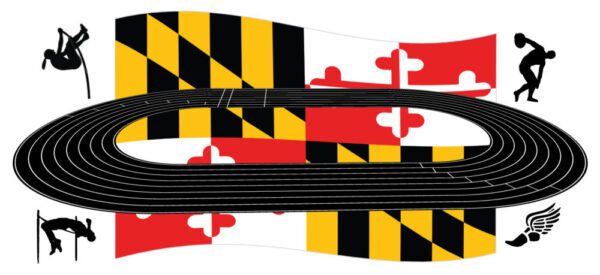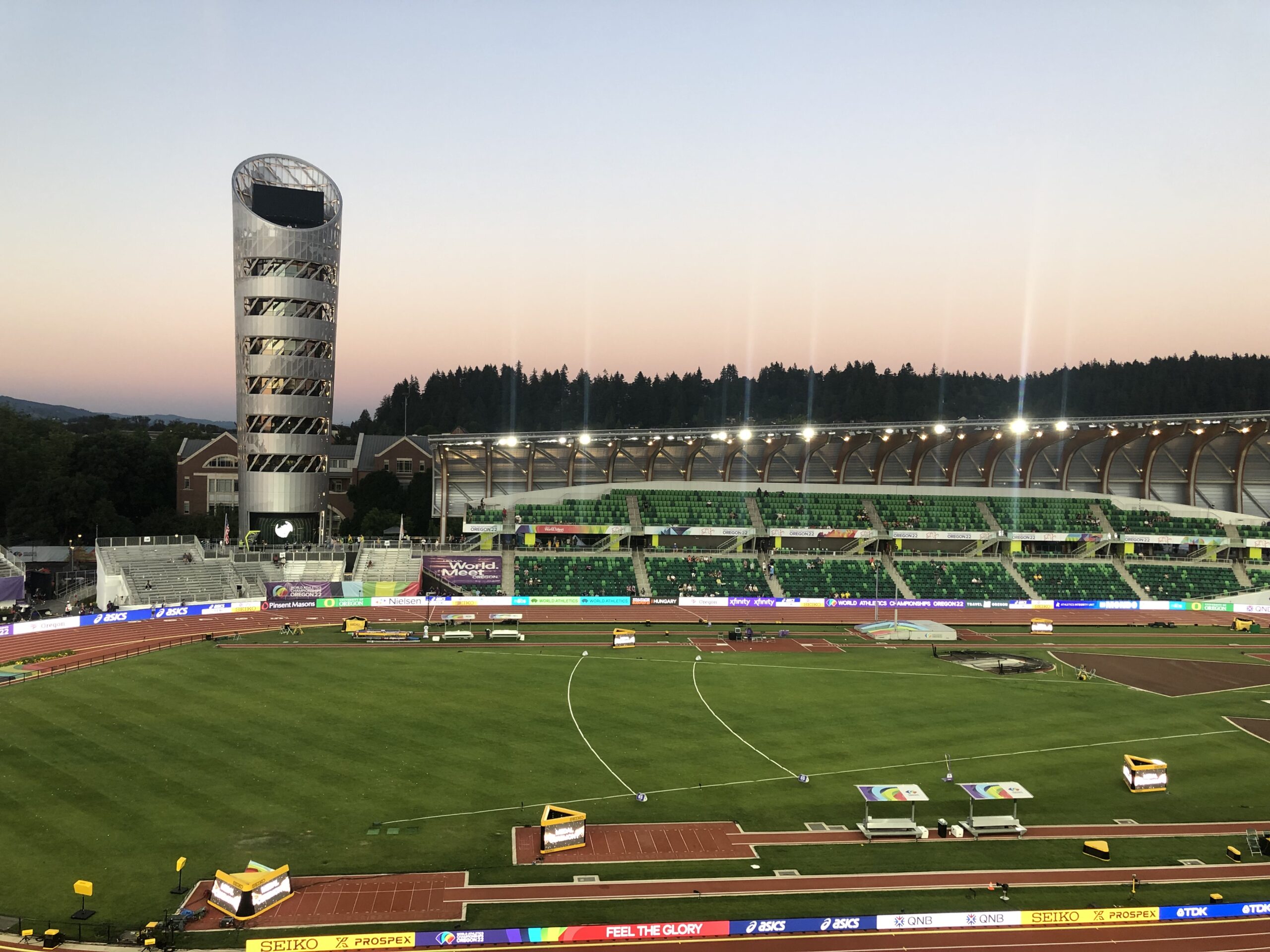Here is a review of the World Athletics Championships. Any feedback is welcome. Contact information is at the bottom. This originally started as me making small notes, then as I put it together, I feel like I may have some cohesion. I apologize for any formatting issues. It’s a WordPress thing.
Positives
Overall, World Championships was a very nice event. There was an engaged and excited crowd, and their reactions were organic. The opening ceremony was very nice, and Seb Coe seems like a dedicated World Athletics President, who really wants to make track a popular sport in the U.S. There were two flyovers during World Championships, and it certainly took a lot to pull that off. The stadium at Hayward is very nice, and most seats in the stadium are great for viewing. Even being on the second level gives a nice view of everything going on for both the track and field. There seemed to be more of a home town crowd as to be expected, but there was certainly some international flavor, which is nice to see. Track and Field is important to many people, but there were some fans who made it clear these are truly heroes to them. Shelly Ann Fraser Pryce seems to hold the same esteem in Jamaica as Taylor Swift does in the states. When the Jamaican sprinters were introduced, the fans were loud and supported their athletes; when the U.S. men swept, it was uproarious which was really neat to see and hear.
The crowd was into all the events. During the men’s shot put, which the U.S. swept, Crouser and company got the crowd going; during the women’s high jump, in which there were no Americans in the final, everyone in the crowd did the rhythmic clap for all competitors. Both 200s were strongly anticipated by the crowd, and both races delivered. For the men’s pole vault, the spotlight was certainly on Mondo, but when he broke the World Record, the stadium erupted.
Six of the sessions were sold out for World Championships, which is less than half of the total sessions, but there seemed to be a strong crowd most nights. Also, if there appeared to be less people on tv, a lot of people were standing along the railing by steeplechase and people were inside the concourse whether milling around or buying food.
Another positive thing about World Championships and track in general is the access to athletes. Everyday, superstars of the world were walking along the concourse, going to restaurants, or going to the local running stores. For the most part, a fan can walk up and get a picture with their favorite athlete.
Negatives
THE US PERFORMANCE AT WORLDS
This is an overall challenge with track. Let’s take triple jump. Transplant Rojas into the U.S. How marketable is she? How many people care she is the World Champion in triple jump? What value does she bring to Nike, Brooks, or whomever. So if you are 22 and just graduated, what do you do? Realistically, you can train 2-3 hours a day instead of watching Netflix. But how do you get a coach? You can’t travel to Europe if you have a regular job. Even if you win, you get 70k, which is great, but what are the chances of that?  The money available from sponsors for field event doesn’t seem to be as much for track runners. Dwight Stones has a good take on things in an article at the end of this, which discusses the possibility of USATF implementing a living wage.
The popularity of track and fIELD PT. 1
A recurring discussion during World Championships is the popularity of the event itself and the popularity of track and field. In the U.S., track is the eighth most followed sport (link at bottom), and Seb Coe’s goal is to make track the fifth most followed sport in the U.S. by the LA games in 2028. Contrary to many people’s initial thoughts, track is certainly not unpopular and this will be discussed more in depth under heading below. Here are some athletes and their Instagram Followers:
Allyson Felix-1,100,000
Sydney McLaughlin-1,100,000
Noah Lyles-298,000
Grant Fischer-42,000
Abby Steiner-151,000
Woody Kincaid-11,700
There is certainly a range of followers from the totally random sample, but still there is enough indication track is popular.
The concerns raised by attendance numbers at Hayward can be answered by many things: oversaturation of the Hayward market, the cost of travel, having to fly to Portland and not Eugene, the event taking place over 10 days, the cost of the event, the host city (town), its lack of proximity to major population cities, and poor press.
However, track is actually an immensely popular sport in America, but we are letting that base sieve away. High school track and field is very popular, but that fandom is not translating. There will more discussion on that later.
The Lack of Leadership by usatf
One can argue for anything in America and say it’s the market/capitalism/business. The good news for track fans is that we have the buyers. There is a big roadblock getting our window shoppers to purchase some goods.
This can not be any surprise. If the leadership of your school, church, business, restaurant, or whatever else is corrupt, incompetent, incapable, lazy, or any other derisive adjective, you are going to have a heck of a time keeping your head above water. USATF is not interested in making track better, and unfortunately, we have to demand better (anybody remember the Jeneba Tarmoh situation). Some accolades of USATF include poor coaching education, poor promotion of events and athletes, and shady elections.
2020 USATF Financials
https://www.flipsnack.com/USATF/usatf-audited-financial-statement-2020/full-view.html
2020 Tax Returns
https://www.flipsnack.com/USATF/2020-form-990-and-related-filings/full-view.html
USATF has 11 people making over $100,000. These individuals should be able to accomplish a lot more.
The popularity of track and fIELD PT. 2:
Becoming a better coach
The success of track and field in the U.S. is truly due to quality high school and youth coaches. Many NCAA coaches do a very nice job, but without high school coaches, the NCAA isn’t much of anything. Young athletes need guidance, and athletes’ success largely hinges upon quality coaching. However, there are far too many coaches who just don’t know what they are doing. In addition to USATF being a poor supporter to keep and bring in fans, coaches also have a responsibility for bringing in a new generation of fans.
While not speaking to everyone, to make track and field more popular, you have to be a better coach, plain and simple. You have to understand track, so that you understand the events, so kids can be successful. When they are successful, they will be enthusiastic. When they are enthusiastic, they will be excited to come to practice. When they are excited and knowledgeable about their event, they will continue to improve and stay in the sport.
You have to follow your sport. You have to be a student of your sport. In the words of Frank Costello, you have to treat your sport like you would a class. Can you imagine a football coach who doesn’t watch football on Sunday? Can you imagine a football coach who doesn’t care about a certain position? Can you imagine a football not caring about cornerbacks and making no effort to learn about the position. That is so many track coaches. If you don’t care about triple jump or discus, you can not be a head coach. You can certainly learn about those events and hire an assistant who is well versed in those events, but if you are a coach who does not check on their field kids during practice or meets because you don’t know anything about the event or because you don’t care or don’t care to learn, you can not be a head coach.
In making track and field more popular, you, as coach must show your enthusiasm for the sport, willingness to learn, and you actually have to watch it when it is on TV.
High School Participation numbers in maryland
Track is not an unpopular sport, at least at the high school level. This is the challenge as coaches, where we can really get kids invested and interested in the sport as fans and not just as college resume builders. According to the NFHS, in the 2018-2019 school year 1,093,621 students in America ran track during the outdoor season. In Maryland, 6,924 boys ran outdoor track and 5,688 girls ran outdoor track. Where are all these numbers going? They aren’t translating to lifelong fans. And keep in mind, there is at least 25% rollover every year. Over a decade, we are talking 2.5 million unique kids are running track, but Hayward doesn’t sell out. Something isn’t adding up.
The difficulty of following track and field
Thank you for reading through this. If you have corrections, comments, or thoughts please send them to Louis at chasingthestandard@gmail.com
Please follow Chasing the Standard on:
Facebook:Â https://www.facebook.com/chasingthestandard
Instagram:Â @chasingthestandard
YouTube:Â https://www.youtube.com/channel/UCzBZv0PKiBF1wiRQ4FjkFtw/playlists
Summary of High School Sports Participation Numbers
2018-2019 NFHS Participation Numbers
https://www.nfhs.org/media/1020412/2018-19_participation_survey.pdf
Article on Attendance Numbers at Worlds
Article on Viewership Numbers for 2022 Worlds
Article on Vin Lananna, possibility of a future World Championship in Eugene, and USATF
Dwight Stones’ Thoughts on Making Changes in the Sport and Track’s Popularity
‘A Living Wage’ Mulled for U.S. Track Athletes, Says Carlsbad’s Willie Banks
https://chasingthestandard.com/2022/07/world-championships-coverage-and-results/

